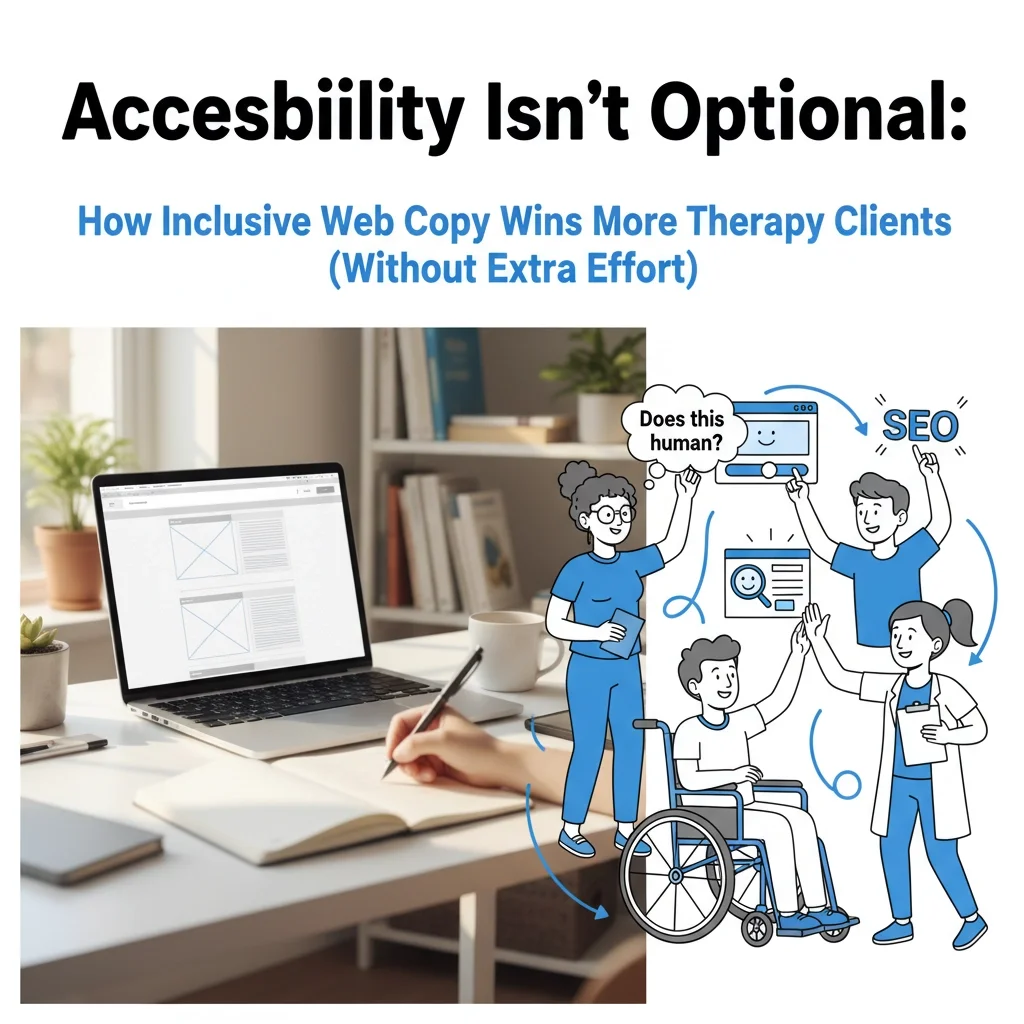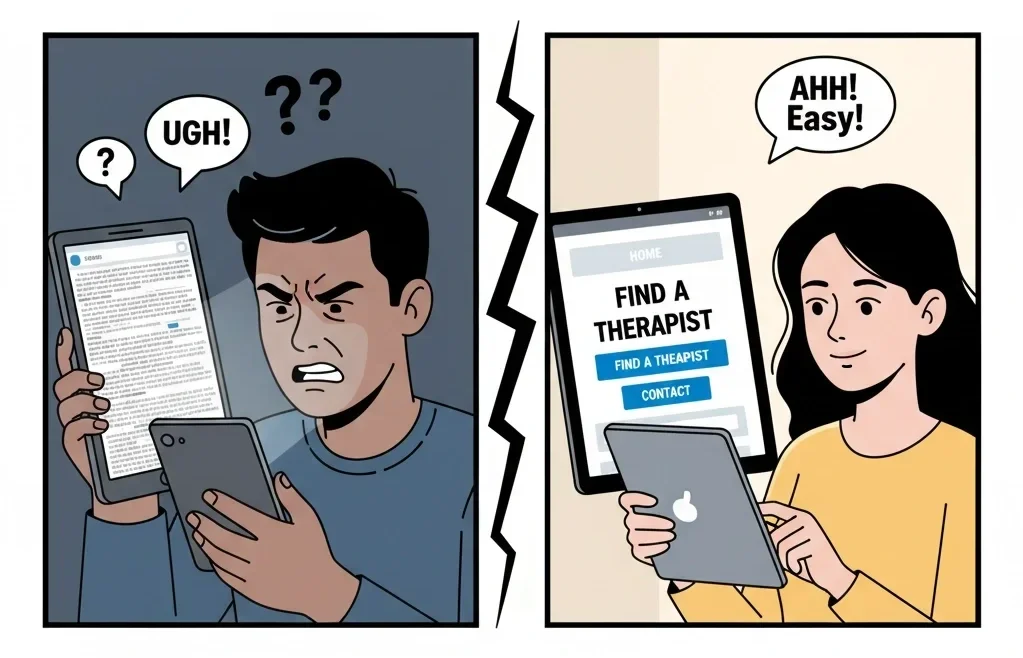Accessibility Isn't Optional: How Inclusive Web Copy Wins More Therapy Clients (Without Extra Effort)
Accessible, inclusive web copy makes your site easier to use and helps more clients reach you
Picture this, A potential client finds your therapy website at 2 AM during a particularly tough night. They're using their phone, struggling with anxiety, and desperately need to know you can help. But your website has tiny text, confusing navigation, and assumes they already know what "CBT" means. They leave. You never hear from them.
Here's the thing, that scenario happens more often than you'd think, and it's completely preventable. When we talk about accessible web copy for therapy websites, we're not just checking compliance boxes. We're opening doors to clients who genuinely need your help but can't reach you through digital barriers.
Why Accessible Copy Is Actually a Client Magnet
Let's get real about the numbers. There are 1.3 billion people globally living with disabilities, representing $13 trillion in disposable income. That's not a niche market: that's a massive audience actively looking for mental health support.
But here's where it gets interesting: accessible design doesn't just serve people with disabilities. It creates a better experience for everyone. When Legal & General made their website more accessible, they saw conversion rates jump by 90%. NPR discovered that their accessibility improvements became a major SEO advantage, bringing in more visitors across the board.
Think about it: if someone with ADHD can easily scan your services page, so can a busy parent researching therapists during their lunch break. If your contact form works with screen readers, it's probably also clearer and more user-friendly for everyone else.
Clear headings, readable fonts, and logical structure improve comprehension and increase conversions compared with low-contrast, tiny type.
The Secret: Good Accessibility Is Just Good Communication
As therapists, you already know how to communicate clearly and compassionately. Accessible web copy simply extends that skill to your digital presence. You don't need to learn a completely new approach: you need to apply what you already do well.
Start With Language That Actually Helps
Your website copy should sound like you're talking to a friend who's nervous about starting therapy. Skip the clinical jargon unless you immediately explain what it means. Instead of "I utilize evidence-based therapeutic modalities," try "I use proven therapy approaches that we'll choose together based on what feels right for you."
This isn't dumbing down your expertise: it's making your expertise accessible. A visitor with a learning disability benefits from clear language, but so does anyone who's new to therapy or feeling overwhelmed by their search.
Structure That Makes Sense to Everyone
Use headings that actually describe what's coming next. Instead of creative titles like "My Journey," try "How I Can Help You" or "What to Expect in Our Sessions." Screen readers rely on these headings to navigate, but they also help anxious visitors find information quickly.
Break up long paragraphs into shorter chunks. This helps people with dyslexia, ADHD, or processing differences, but it also makes your content more scannable for everyone. Nobody wants to read a wall of text when they're researching therapists.
Practical Changes That Take Zero Extra Effort
Color and Contrast That Actually Works
You know how you sometimes struggle to read text on your phone in bright sunlight? People with visual impairments face that challenge constantly. Using sufficient color contrast between your text and background isn't just accessible: it's professional and easy to read for everyone.
The WCAG standard calls for a 4.5:1 contrast ratio for normal text. There are free online tools to check this, and most website builders now highlight contrast issues automatically. It's easier than you think.
If your text whispers gray on white, nobody can hear it. High contrast says “hey, read me” and passes WCAG checks.
Images That Tell Their Story
Every image on your website should have alt text: a brief description that screen readers can share with visually impaired visitors. But here's the bonus: alt text also helps with SEO and provides context when images don't load properly.
Instead of generic alt text like "therapy session," be specific: "therapist and client having a conversation in a comfortable office setting with natural lighting." This helps everyone understand what they're looking at and reinforces the welcoming atmosphere you're trying to create.
Multiple Ways to Connect
Not everyone can use contact forms. Some people need to call directly, others prefer email, and some require text-based communication due to hearing differences. Offer several contact options, and make sure each one is clearly labeled and easy to find.
This isn't extra work: it's smart business. You're meeting potential clients where they are and removing barriers to that crucial first connection.
The Neurodiversity Advantage
When you design for neurodivergent visitors, you're tapping into a population that often struggles to find understanding mental health providers. Clear navigation, predictable layouts, and sensory-friendly design choices signal that you truly understand different ways of experiencing the world.
Consider adding simple features like:
A brief explanation of what to expect on each page
Clear instructions for forms and processes
Options to adjust text size or reduce animations
Consistent placement of navigation elements
These choices communicate competence and empathy before a client ever meets you.
Gentle, predictable layouts support diverse processing needs so you and your clients can focus on connection, not confusion.
Why This Isn't Actually Extra Work
Here's the beautiful truth about accessible design: it makes everything better. When you write clearly, structure logically, and remove barriers, you're not just helping people with disabilities: you're creating a website that performs better for everyone.
Accessible sites typically have:
Lower bounce rates (people stay longer)
Better SEO performance (search engines love clear structure)
Higher conversion rates (fewer barriers mean more action)
Improved user satisfaction across all demographics
You're not doing special work for a small group: you're building a better experience that naturally attracts more clients.
The Trust Factor
Think about what accessibility communicates about you as a therapist. When someone with a disability can easily navigate your website, schedule appointments, and access your resources, you're demonstrating the very qualities they need in a mental health provider: understanding, patience, and genuine care for their experience.
This builds trust before the first session even happens. Potential clients can see that you consider different needs and perspectives: exactly what they want in someone who'll be helping them navigate life's challenges.
Simple Steps to Start Today
You don't need a complete website overhaul. Start with these quick wins:
Review your "About" and "Services" pages for jargon and replace complex terms with plain language
Check your color contrast using a free online tool and adjust if needed
Add descriptive alt text to your main images, focusing on the emotion and context
Test your contact options to ensure they all work properly and are easy to find
Ask for feedback from clients with different abilities: they'll tell you what's working and what isn't
Each of these steps takes minutes but opens your practice to clients who might otherwise go elsewhere.
The Real Bottom Line
Accessible web copy isn't a compliance checkbox or a nice-to-have feature: it's a competitive advantage that directly impacts your ability to connect with clients who need your help. When you remove digital barriers, you're not just following guidelines. You're expanding your reach, improving user experience, and demonstrating the inclusive, client-centered approach that makes great therapy work.
Want to see how inclusive design could transform your website's ability to connect with more clients? We'd love to help you create a digital presence that truly welcomes everyone who needs your support.





